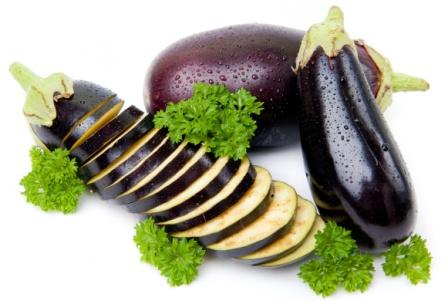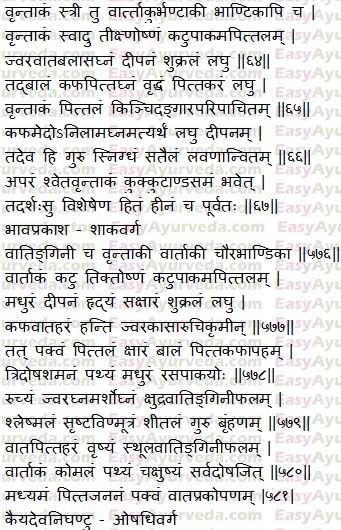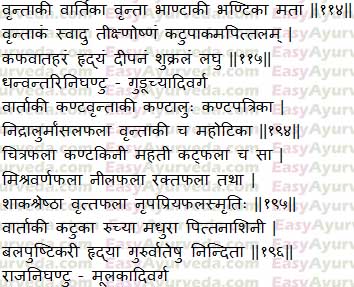Eggplant – Uses, Remedies, Qualities, Recipes, Research
By Dr Renita D’Souza
Eggplant is the King of vegetables. It is used for culinary purposes and in traditional medicine. Delicious Brinjal recipes like Chutney, Curry, Pickle and dishes like Baingan bharta or gojju, Begun-pora (burnt/charred brinjal), Bharli vangi, Vangi bhat etc are popular in South Asian countries. (read more about brinjal recipes here)
Eggplant is considered as one among the wholesome diet for natural healing of low back pain and piles. It is not recommended in headache. Brinjal-Castor oil recipe is the best Ayurvedic recipe for Rheumatoid arthritis (amavata).

Botanical Name – Solanum melongena
Family – Solanaceae
Read – Pumpkin – Benefits, Remedies, Recipes, Oil, Nutrition and Research
Table of Contents
Vernacular Names
English Name – Brinjal, Eggplant, Aubergine
Hindi Name – Bhanta, Baingan, Baiguna, Baijani
Bengali Name – Beguna
Marathi Name – Vange, Vangi
Gujarati Name – Ringana, Vantaka, Baingan
Kannada Name – Badane
Malayalam Name – Vazhudana
Telugu Name – Vankaya
Tamil Name – Katarikai, Kattiri
Spanish Name – berenjena
French Name – mélongène
Arabic Name – bâdhingân
Portuguese Name – berinjela
German Name – Eierfrucht
Italy – maranziana, melenzana, mulignana, petrociana
Japan Name – nasu
Netherlands Name – eierplant
Sweden Name – Äggplanta
Malaysia Name – terong
Chinese Name – qie, qie zi, ai gua / ngai gwa (A)
Medicinal Qualities
Taste – sweet
Potency (virya) – hot
Vipaka (taste conversion after digestion) – pungent
Tikshna – penetrating in nature
Laghu – light to digest
Deepana – kindles digestive fire
Hridya – cardiac tonic
Shukralu – increases quality and quantity of sperm
Read – Bottle Gourd Uses, Home Remedies, Side Effects, Research
Effect on Tridoshas
Apittalam – slightly increases pitta dosha
Vatabalasagnam – balances excess vata and kapha dosha
Uses
Jwara – fever
Kasa – cough
Aruchi – anorexia
Krimi – intestinal worm infestation
As per mentioned in Astanga Hridaya Sutrasthana 6th Chapter
Brinjal is pungent, bitter, hot in potency, sweet, mitigates kapha and vata, is slightly alkaline, kindles digestion, improves taste and does not aggravate pitta
As per the Nighantus, Brinjal is one among the 4 substances (Black gram, Curds and Fish) that increases kapha and pitta.
Read – Winter Melon Health Benefits, Medicinal Use, Side Effects
Unripe Brinjal
Balances kapha and pitta dosha
Ripe Brinjal
Guru – heavy to digest
Pittakaram – increases pitta dosha
Kshara – alkaline in nature
Brinjal cooked on Embers
Medogna – reduces fat tissue
Amagna – reduces ama (metabolic tissue)
Atyartham laghu – very light to digest
Deepana – kindles digestive fire
Effect on Tridoshas –
Kinchit pittalam – slightly increases pitta dosha
Balances excess kapha and vata dosha
If this brinjal is mixed with oil and salt, then it becomes heavy to digest (guru) and unctuous (snigdha).
Read – Cowpea – Vigna unguiculata (Lobia) – Qualities, Benefits, Research
Brinjal – Small size
Shudravatingini
Taste – sweet
Vipaka (taste conversion after digestion) – sweet
Pathya – wholesome
Ruchya – improves taste
Jwaraghna – relieves fever
Arshoghna – cure piles
Effect on Tridosha –
Tridosha shamanam – balances all three doshas – vata, pitta and kapha
Kshudravartakikaphala
Reference – Bhojana Kutoohala
Taste – Pungent
Vipaka (taste conversion after digestion) – Pungent
Ruchya – improves taste
Swaryam – improves voice
Treats –
Jwara – fever
Shwasa – asthma
Kasa – cough
Arshas – piles
Brinjal – large
Sthulavatingini
Virya (potency) – cold
Guru – heavy to digest
Brihmana – nourishes
Vrishya – aphrodisiac
Srishta vinmutra – excretes feces and urine
Effect on Tridoshas –
Vatapittahara – balances excess vata and pitta dosha
Shleshmala – increases kapha dosha
Read – Carrot (Gajar): Benefits, Remedies, Research, Side Effects

Dry and Fried Brinjal
Shushka and Taila Brishta Vartaka
Reference – Bhojana Kutoohala
The dry brinjal or brinjal fried with sesame oil is a good appetizer.
White Eggplant
Sanskrit Name – Swetha vrintaka
Hindi Name – Saphed baingan
White eggplant looks similar like chicken white eggs. This variety is inferior in quality and used specially in piles (arshas).
Read – Pointed Gourd Health Benefits, Usage – Ayurveda Details
Sanskrit Verses


Read – Orange Fruit Uses, Remedies, Research, Side Effects
Remedies
- For allergic rhinitis – 15-20 seeds of Brinjal (Vrintaka) are taken, crushed well and made into fine powder. This is used as errhine (nasya) twice or thrice in a gap of 15-20 minutes.
- Piles – Fruit ash is used in a dry hot poultice to treat piles. This is practiced in Malaysia.
- The root is crushed and applied inside the nostrils to treat ulcers.
- The fresh or dry leaf and fruit is known to reduce blood cholesterol level.
- Otitis and Toothache – root juice is used.(read)
Eggplant Bad for Skin Diseases?
Addition By – Dr MS Krishnamurthy MD (Ayu), PhD
Acharya Charaka refers Vrintaka as a Pathya (wholesome) in one of the context should be re-validated with respect to Dosha as well as particular variety and combination. It can be taken as a research topic by the knowledge seekers.
Chemical composition of Brinjal:
The eggplant is abundant in phenolic compounds in the fruit (chlorogenic acid) and it is the most common allergen to human beings. Eggplant is high in histamines which is another factor for allergic manifestations.
Rationality on the basis of Ayurvedic principles:
Brinjal is Kapha-pittavardhaka (increases Kapha and Pitta) and decreases Vata Dosha. Moreover it disturbs Pitta dosha (Pachaka-ranjaka and bhrajaka pitta) followed with Kapha dosha (Kledaka-Shleshaka kapha) in their respective places of occupation(site).
Due to this, free movement of the dhatus (tissues) especially in Rasa, Rakta (blood), Mamsa (muscle) and Meda (fat) tissue are obstructed. Hence dhatwagni dushti (altered metabolism at tissue level)is caused.
Further in turn it leads low digestion strength at tissue level (dhatu Agnimandya) and dhatu vaishamya – vitiation / imbalance in tissues. This leads to tissue toxicity.
This leads to sepsis (dhatwagnimandyajanya vishaktata) and thus becomes the reason for all ailments associated with skin. This acts as a hurdle for the medicine action leading to medicinal toxicity (oushadha Ajeernata).
Thus it increases the burden of the skin disease treatment.
Probably with this reason the tradition as well as Ayurverdic practice restricts the usage of brinjal in such cases that too in skin diseases or blood borne diseases of any king including blisters, abscess, cysts, boils, itching skin lesions, eczema, allergic dermatitis, tinea infection etc.
I will be eagerly waiting to get more explanation in this regard.
Interaction with medicines, supplements
Can this be used while taking Homeopathic medicine?
Yes. This product does not react with homeopathic medicine.
Can
this medicine be continued while taking supplements like multivitamin tablets,
Omega 3 fatty acids etc?
Yes. Generally, this product goes well with most
of the dietary supplements. However, if you are taking more than one product
per day, please consult your doctor for an opinion.
With western
medicines
Seek your
doctor’s advice if you are taking this product along with other western
(allopathic / modern) medicines. Some Ayurvedic herbs can interact with modern
medicine.
If both Ayurvedic and allopathic medicines are advised together, then it is
best to take Allopathic medicine first, wait for 30 minutes and then take the
Ayurvedic medicine.
Nutritional Values
Brinjal contains calories, Carbohydrates, Fiber, Protein, Manganese, Folate, Potassium, Vitamin K, C. It also contains niacin, magnesium and copper in small amounts. (read more)
Brinjal Recipes
Reference – Kshemakutuhalam
Ennegai Traditional Karnataka EggPlant Gravy with a Twist
- Brinjal with stalk is cut and boiled in sour gruel with tamarind. Then, cooked with ghee, coriander, ginger and turmeric. It is added with salt, black pepper powder and dipped in oil mixed with asafeotida.
Uses – the fragrance of this recipe itself arouse the appetite. - Brinjal is cut into pieces and dipped in the oil along with water containing asafetida. Then, cooked under the cover and finally dressed with black pepper powder.
- Unripe green brinjal dipped in mustard oil containing asafetida and garnished with black pepper is slightly hot in nature and improves taste and appetite.
- Brinjal is cut into pieces and smeared with dry ginger, coriander and cumin seeds. Then, fried in ghee along with black pepper and sprinkled with asafetida powder.
- A brinjal with stalk is cut into pieces and fried in ghee with asafetida. This is added with rock salt and Garcinia pedunculata. This can be eaten with Roti.
- Stalked brinjal pieces are mixed with asafetida and cooked in ghee along with mango.
- Brinjal cooked in best ghee along with a paste of rice grains and coconut gratings added with black pepper and cardamom improves the digestive fire.
- Brinjal pieces are boiled in water and cooked in oil along with lemon extract, asafetida, wet ginger and mixed with gravy and rock salt.
- Bhatitrikam Recipe – Brinjal is burnt in coal, smashed and cooked in ghee with rock salt, asafetida and dressed with spices.
- Brinjal without skin is cooked underground (Putapaka method) and then mixed with rock salt, ghee and asafetida. This dish improves appetite and taste.
- Brinjal with stalk is cooked in high flame, mashed and imparted fragrance with mustard and rock salt. Before serving it is kneaded with curds.
- Seedless unripe brinjal is cooked in smokeless fire and mixed with wet ginger, lemon, rock salt and oil. This recipe improves appetite and taste.
- Brinjal with half its stalk is boiled and cooked with muskmelon (Cucumis callosus), mixed with cumin seeds, ghee and veshavara.
Phytochemical Constituents
Aqueous extract of Solanum melongena Linn possess flavonoids, alkaloids, glycosides, saponins, tannins, sterols, carbohydrates, fixed oils and resin.
Research
Anti-inflammatory activity – A research study done to evaluate anti inflammatory activity of aqueous extract of leaves of Solanum melongena Linn. in experimental animals have proved its potent anti inflammatory activity.
Morphology, Distribution
Morphology
Solanum melongena is a shrub which grow up to meters in height. The stem and leaves are covered with star-shaped hairs. Leaves are coarsely lobed and arranged alternately. Flowers are purple to white in color. Fruit fleshy berry, smooth, shiny, globose to oblong in shape, contains many seeds. Color of the fruit varies from white, green, purple or black. Seeds are numerous, small, soft, kidney or lentil shaped, pale brown in color, edible and bitter in taste due to nicotinoid alkaloids.(A)
Distribution
Eggplant is found in China, India, Myanmar
Ayurvedic Medicines
Breathvin Ghrita – used for all kinds of asthma and related complaints.
Prasoothika Kashayam – It is an ideal tonic after delivery for restoring health, used in gynaecological disorders, rheumatic diseases and nervous debility.
Sathavaryadi Kashaya Choornam – used in neurological problems, rheumatic complaints, nervous debility and numbness.
Asthavin Lehya – used for the treatment of respiratory disorders
Punarnavarishta – used in the treatment of inflammatory disorders, liver disorders associated with itching etc
Sanskrit Synonyms
Vrintaka, Vartaaku, Bhantaki, Bhaantika
Vatingini, Vrintaki, Vaartaaki, Chourabhandika
Categorization
Classical Categorization
Bhavaprakasha Nighantu – Shaka varga
Kaiyadeva Nighantu – Aushadhi varga
Dhanvantari Nighantu – Guduchyaadi varga
Scientific Classification
Domain – Eukaryota
Kingdom – Plantae
Phylum – Spermatophyta
Subphylum – Angiospermae
Class – Dicotyledonae
Order – Solanales
Family – Solanaceae
Genus – Solanum
Species – Solanum melongena
Eggplant, cooked, boiled, drained, without salt
Taste – sweet
Properties – light, sharp, piercing
Potency – hot
After digestion taste transformation ( Vipaka ) – pungent
Effect on Doshas
Vata balancing
Pitta nourishing (is deepana)
Kapha balancing (more Kapha balancing as it is cooked which makes it further light)
Eggplant, cooked, boiled, drained, with salt
Taste – sweet, slightly salty
Properties – light, sharp, piercing
Potency – hot
After digestion taste transformation ( Vipaka ) – pungent
Effect on Doshas
Vata balancing
Pitta nourishing (is deepana, salt is Pittakara)
Kapha balancing (more Kapha balancing as it is cooked which makes it further light)
Click to Consult Dr Renita D’Souza









